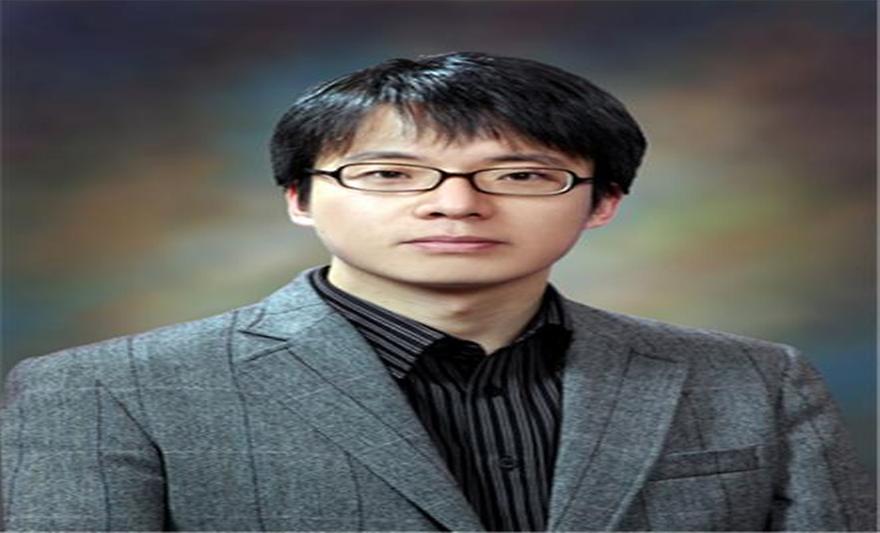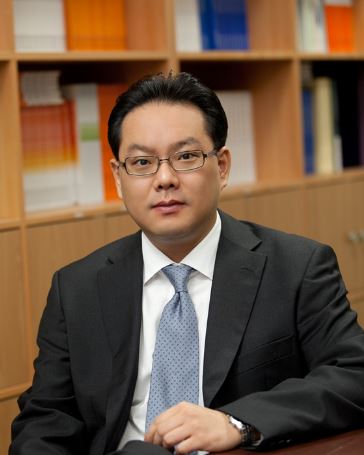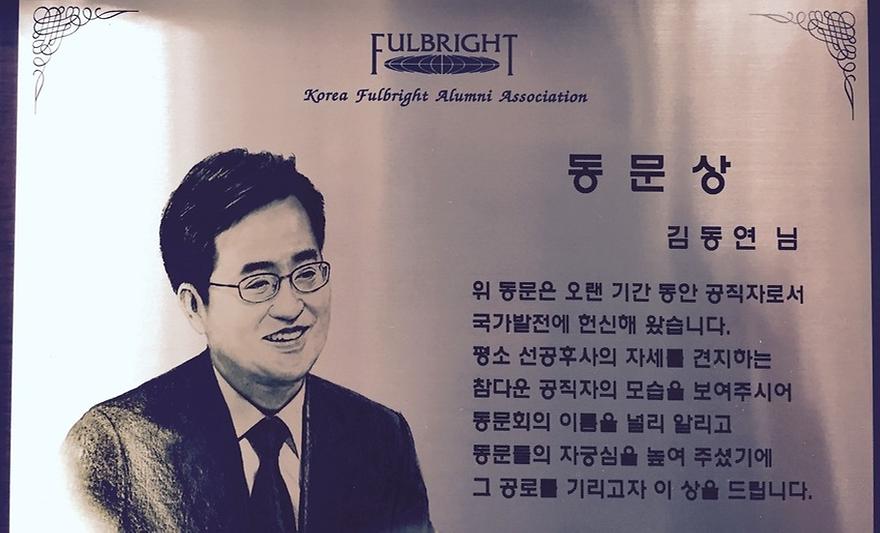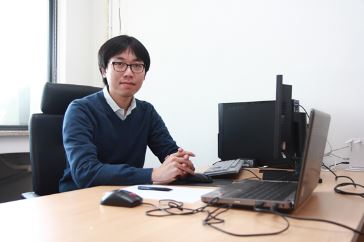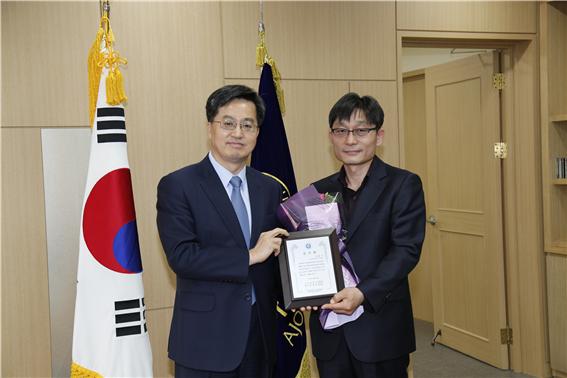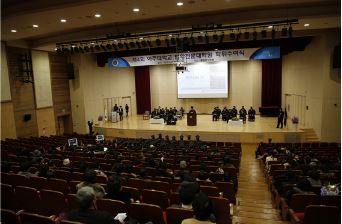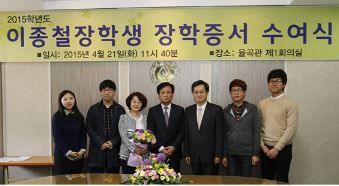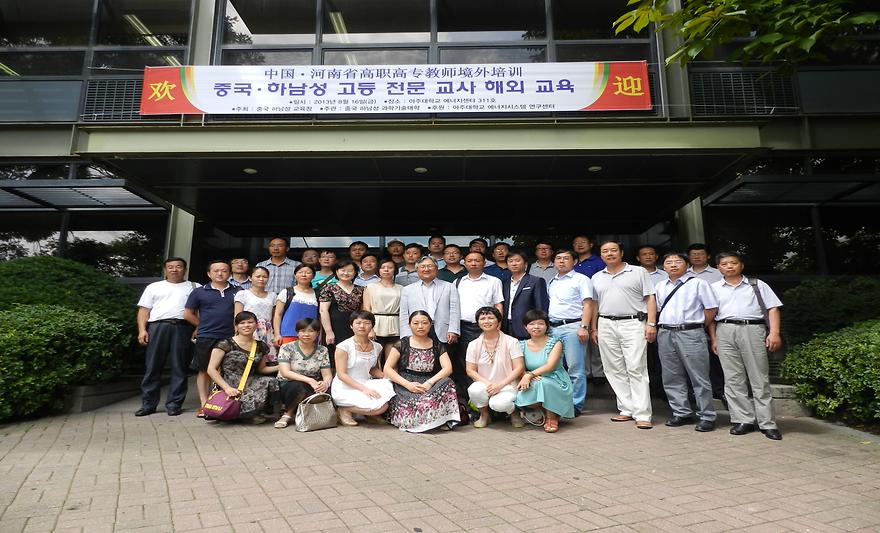-
A research team led by Ajou University’s Professor Dong Il Yeom (Department of Physics, Graduate School’s Department of Energy System Research, pictured above) has developed graphene-optical fiber devices available for electrical control for the first time in the world. Graphene, a single atomic layer that combines carbon atoms in a beehive shape, is drawing attention as a “new dream material” since its high conductivity, transparency, and flexibility allow for the production of next-generation electric devices, photoelectric devices, and optical devices such as semiconductors, displays, and solar cells. However, it has been difficult to make optical devices and photoelectric devices with highly efficient photoreaction capacities from the single-layer graphene because its light absorbing rate is around a mere 2.3%. The research team led by Professor Yeom developed the world’s first graphene-optical fiber photoelectric devices by combining Field Effect Transistor (FET) and optical fiber, which has previously been difficult due to technological limitations. The team also succeeded in developing an ultra-short pulse optical fiber laser that can be electrically controlled via photoelectric devices. FET is called a unipolar transistor because only single polarity electrons are involved in the electricity conduction within semi-conductors. The photoelectric device developed by the research team is highly efficient, allowing for adjusting the light absorption rate up to 90% through interactions between graphene and the damped wave (evanescent wave) generated by the light moving along optical fiber. Professor Yeom said, “The graphene-optical fiber photoelectric device our team has developed can be directly applied to the optical fiber laser that is now being used in precise laser processing for industrial uses or in building laser-enabled weapons. I expect that the device can also contribute to developing photoelectronic or optical devices based on highly efficient graphene.” The research findings were published in the April 2015 issue of Nature Communications, a world-class science journal (Impact Factor over the past 5 years: 11.023), with the title of “Active Control of All-fiber Graphene Devices with Electrical Gating.” Eun Jeong Lee (graduate from the University’s master’s course), Seon Yeong Choi (postdoctoral course), and Hwan Seong Jeong (combined master’s/PhD program) took part in the research as first authors, and Professor Fabian Rotermund (co-corresponding author), Professor Ji Yong Park, Professor Yeong Hwan Ahn, and Professor Gwang Jun Ahn collaborated with the research team. The study was conducted with the support for basic research projects carried out by the Ministry of Science, ICT and Future Planning and the National Research Foundation of Korea.
-
37
- 작성자OIA
- 작성일2015-05-06
- 23421
- 동영상동영상
-
-
35
- 작성자OIA
- 작성일2015-05-06
- 23789
- 동영상동영상
-
-
33
- 작성자OIA
- 작성일2015-05-06
- 22401
- 동영상동영상
-
A team led by Professor Sung Hwan Kim (pictured above. Department of Physics and the Graduate School’s Department of Energy System Research) from Ajou University succeeded in developing a human-body-friendly bio sensor by using silk obtained from silkworms. The achievement of Professor Sung Hwan Kim’s team was published on April 1st in the online issue of Nano Letters, a renowned international academic journal in the field of nano studies. The paper is entitled “A Highly Tunable and Fully Biocompatible Silk Nanoplasmonic Optical Biosensor.” Myeong Jae Lee (doctoral course, first author) and Professor Heon Su Jeon (co-author) from the Department of Physics and Astronomy of Seoul National University also took part in the research. The nano bio sensor developed by Professor Kim’s team is compatible with the human body because it uses silk obtained from silkworms, and it also has a high detection rate. Therefore, the sensor is expected to be widely used for smart healthcare, which is emerging as a next-generation growth engine for IT companies. The team extracted liquid-state silk protein from silk worms and created nano optical elements with a gold nano structure on silk films by utilizing semi-conductor processing technology. Bio sensors made through this process showed detection sensitivity rates 5-6 times higher than those of existing ones. Professor Kim explained, “By inserting very thin silk films inside a gold nano structure, the volume of the films expands as they respond to water or chemical substances such as alcohol,” adding, “You can achieve high detection sensitivity as the light wavelength to which nano optical elements respond extends with the films’ expansion.” Professor Kim went on to say, “The research is significant in that it has opened the possibility for silk protein, which has only been considered a fiber to this point, to be recreated as a human-body-friendly bio sensor,” adding, “I expect the research to provide insight for future studies regarding the healthcare market.” The study was conducted with the support for basic research projects (for new researchers and leading research centers) carried out by the Ministry of Science, ICT and Future Planning and the National Research Foundation of Korea.
-
31
- 작성자OIA
- 작성일2015-04-29
- 22521
- 동영상동영상
-
-
29
- 작성자OIA
- 작성일2015-04-29
- 22092
- 동영상동영상
-
Of the Ajou University Law School graduates, 90.2% passed the fourth Korea Bar Exam, which is the third-highest rate among domestic law schools. The average rate of graduates passing the Exam for all domestic law schools was 74.7%. On April 10th, the Ministry of Justice announced the list of those who passed the fourth Bar Exam. According to the list, 46 applicants from among the 51 first-time test-takers from Ajou’s Law School passed the Exam, achieving a pass rate of 90.2%. The figure is far higher than the average pass rate among applicants from a total of 25 law schools in Korea. The Ministry of Justice said, “Based on the first-time test-takers, the nationwide pass rate for the Exam averaged 74.7%.” ‘First-time test-takers’ refers to those who took the Bar Exam for the first time this year. According to Ajou University Law School, the pass rate of its graduates for the latest bar exam was the third-highest, with Yeungnam University being the highest at 98.44%, followed by Seoul National University and Ajou University. Ajou’s Law School also recorded high pass rates in the first three bar exams. In the first exam conducted in 2012, its pass rate was 100%, and its rates for the second and third exams were 88.64% and 90.48%, easily surpassing the national averages of 72.55% and 67.63%, respectively. * The above picture is a scene from the fourth graduation ceremony for Ajou’s Law School, which was held on January 29th.
-
27
- 작성자OIA
- 작성일2015-04-29
- 22457
- 동영상동영상
-
-
25
- 작성자OIA
- 작성일2015-04-27
- 22281
- 동영상동영상
-
A ceremony was held on April 21st in Conference Room 1 of Yulgok Hall to present the first certificates for the Lee Jong Cheol Scholarship. During the ceremony, CEO Jong Cheol Lee of Dong Seong Metal presented scholarship certificates to four students. Last October, Jong Cheol Lee contributed 100 million won in scholarship funds, and the University decided to grant scholarships of 10 million won per semester in the name of the Lee Jong Cheol Scholarship. The scholarship presentation was the first one under the University’s schedule, and the certificate recipients were two students from the Department of Pharmacy and two students from the Department of Materials Science and Engineering. CEO Lee is a graduate from the 43rd Advanced Management Program under the University’s Graduate School of Business Administration. He has continually made contributions as a director of the Akyung Scholarship Foundation, which was established by the alumni of Ajou’s Graduate School of Business Administration and grants scholarships only to Ajou students. Seong Hwan Kim (Department of Materials Science and Engineering) expressed his appreciation as the representative of the scholarship recipients by saying, “This scholarship allows me to please my parents. It acts as motivation for me to study harder, and I will cherish the wishes of the scholarship contributor.” CEO Lee said, “I make contributions to enrich my mind by sharing what I have, rather than just living an affluent life.” The ceremony was attended by CEO Lee and his wife, President Dong Yeon Kim, Professor Kyung Hyun Ko (Department of Materials Science and Engineering), Professor Hong Pyo Kim (Department of Pharmacy), and Vice President for Student Affairs Jai Hyoung Cho, etc.
-
23
- 작성자OIA
- 작성일2015-04-27
- 22059
- 동영상동영상
-
-
21
- 작성자윤정용
- 작성일2014-08-12
- 34224
- 동영상동영상
-
Ajou holds sixth Korea-China-Japan Engineering Workshop Ajou University recently held the 2013 Engineering Workshop with universities from Korea, China and Japan. The workshop is held annually and saw the participation of Ajou University from Korea, Shandong University from China, and Kumamoto University from Japan; it is aimed at strengthening research networks among the universities. This marks the second time Ajou University has held the workshop after its first hosting in 2010. This sixth workshop was held from Nov. 7 to 9, with around 60 science and engineering experts from the fields of computer engineering, electric engineering, chemical engineering, and biochemical engineering in attendance. Forty-three presentations were given over the course of the three days. Participating in the workshop from Ajou University were Choi Yun-Ho, dean of the College of Engineering, LEE Hyung Chun, dean of the College of Natural Sciences, Kwon Yongjin, vice dean of the College of Engineering, as well as professors Lee Taek Kyun, Kim Kangseok, Jeon Youngmok, Lee Kijung, Jung Jaewon, Kim Moonsuk, Kim Wook, Yoon Hyun C., Shin Gwy-Am, and others. Ajou University also held a research lab experience program for 12 scholarship students from Kumamoto University in Japan. The students visited Ajou University during the workshop period and participated, up to Nov. 13, in research activities in 10 research labs.
-
19
- 작성자OIA
- 작성일2013-12-03
- 32145
- 동영상동영상
-
-
17
- 작성자OIA
- 작성일2013-12-03
- 32617
- 동영상동영상
-
Ajou University signs dual degree program agreement with Namkyung University of Science and Engineering in China Ajou University recently signed a dual degree program agreement with Namkyung University of Science and Engineering in China. President of Ajou University Dr. Jae-hwan Ahn visited Namkyung University of Science and Engineering in China, for four days from Nov. 20, signing the agreement during his visit. Planning Director Min-koo Kim and Head of the International Cooperation Team Jae-eun Kim accompanied the president to China. Under the agreement, the two universities will conduct student exchanges in which students from each institution will be allowed to study in China or Korea toward obtaining a dual degree from each university. Specifically, the dual degree system is one in which a student earns a certain number of credits at Ajou University (at least 1/2 of graduation credits) and the remaining credits from the other university, thereby obtaining degrees from both universities. The International Cooperation Team of Ajou University has made continuous efforts to expand the dual degree program, which has until now focused on sister universities in the United States (Stony Brook University and Illinois Institute of Technology) and in Australia (Sunshine Coast University), to include more universities in Asian countries, including China. Namkyung University of Science and Engineering is located in Namkyung (Nanjing) in Jiangsu; it signed a sister university agreement with Ajou University in 1995. Namkyung University has 12 colleges, including the College of Chemical Engineering, the College of Electric Engineering, and the College of Humanities, and has been recognized for excellence in the area of science and engineering. President Ahn during his visit participated in the celebratory events held to mark the 60th anniversary of the foundation of Namkyung University of Science and Engineering, and met with the Ajou University students currently studying at Namkyung University as exchange students. A total of 10 students are studying as exchange students at Namkyung University of Science and Engineering this year.
-
15
- 작성자OIA
- 작성일2013-12-03
- 32830
- 동영상동영상

